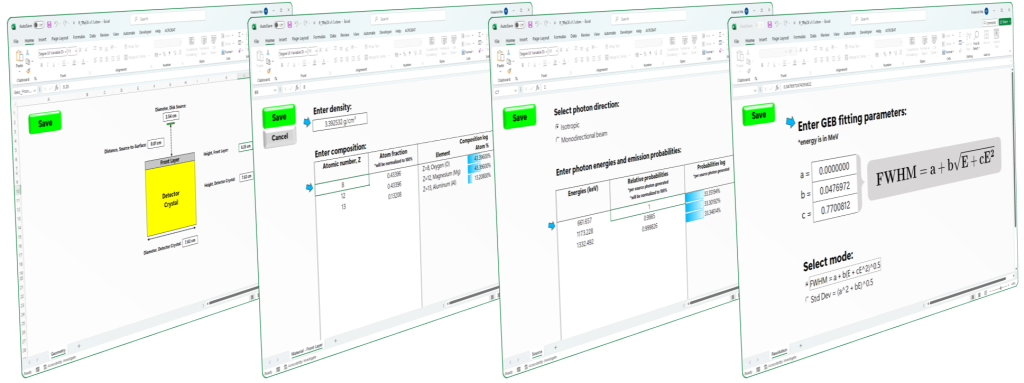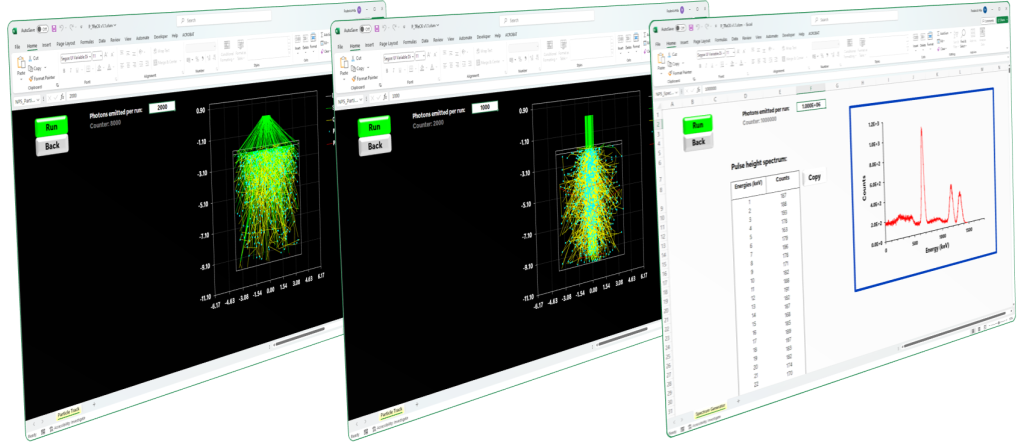Detector Materials Simulations
DETMATS is an innovative Microsoft Excel-based tool featuring open VBA code, designed for modeling photon transport and energy deposition in radiation detection materials. By utilizing the EPICS2023 photoatomic data library, DETMATS provides researchers and practitioners in physics and radiation science with a user-friendly tool for exploring and characterizing radiation detectors.


Key Features of DETMATS
- User-Friendly Interface: DETMATS features intuitive and customizable interfaces. Consequently, users can modify parameters without requiring programming knowledge. This simplification makes the setup of Monte Carlo simulations accessible to individuals with varying skill levels.
- Open VBA Code: The tool features open Visual Basic for Applications (VBA) code, enabling users to dissect, modify, and expand it to suit their specific needs. Consequently, this approach fosters the educational development of functional Monte Carlo codes across various institutions.
- Comprehensive Photon Transport Model: DETMATS accurately simulates key photon interaction processes, such as photoelectric absorption, Compton scattering, and pair production. It achieves this by using detailed cross-section data from the EPICS2023 library.
- Adjustable Detector Geometry: The tool features a basic cylindrical detector model with adjustable dimensions. This design allows for quick simulations in radiation detector characterization and offers the flexibility needed for different research contexts.
- Customizable Material Composition: Users can define the elemental compositions and densities of materials used in simulations, making it adaptable to a range of applications.
- Robust Energy Resolution Modeling: DETMATS implements Gaussian energy broadening (GEB) techniques to realistically model the energy resolution of real-world detectors, using established models suited for various detection technologies.
- Interactive Simulation Outputs: Users can generate response spectra for radiation detectors or visualize particle tracks within the modeled geometry. These features offer immediate insights into the detector’s behavior, and the spectra can be exported for further analysis, enabling detailed qualitative and quantitative assessments of the simulation results.
- Capable Vectorized Algorithm: The tool uses a vectorized implementation of transport algorithms, processing multiple photon particles simultaneously for each interaction type. This enhances computational efficiency without compromising accuracy.
How to Cite
Hila, F. C., Guillermo, N. R. D., Amorsolo, A. V., Jr., & Mercado, C. C. (2024). A new Excel-based Monte Carlo transport code for simulating energy response spectra and efficiencies in gamma-ray detection materials. Radiation Physics and Chemistry, 218, 111616. https://doi.org/10.1016/j.radphyschem.2024.111616
Changelog
Version 1.2 (July 2024)
Initial release of DETMATS.